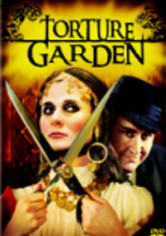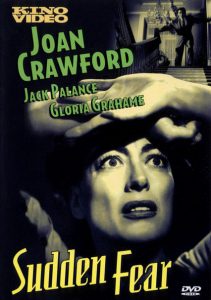Torture Garden-1968
Director Freddie Francis
Starring Burgess Meredith, Jack Palance, Peter Cushing
Scott’s Review #1,027
Reviewed May 28, 2020
Grade: B
A horror offering made up of multiple vignettes is a treat, offering numerous stories, especially with some late-1960s British sophistication peppered in.
Torture Garden (1968) contains four stories- Enoch, Terror over Hollywood, Mr. Steinway, and The Man Who Collected Poe, each with some intrigue. The structure may be most comparable to The Twilight Zone television series, but in a British way.
The Terror over Hollywood is my personal favorite.
Burgess Meredith (yes, that Burgess Meredith of the Batman television series) stars as Doctor Diabolo, a sinister con artist who runs an attraction at a fairground sideshow.
Having shown them a handful of tepid haunted-house-style gimmicks to whet their appetites, he promises a frightening experience if they pay extra.
Of course, they are immediately taken, and when they follow him behind a curtain, one by one, they view their fates through a transfixed female deity, Atropos (Clytie Jessop).
The stories commence through a hallucinogenic method.
Below is a summary and review of each vignette.
In Enoch, Colin Williams (Michael Bryant), a greedy playboy with money troubles, takes advantage of his elderly uncle (Maurice Denham) by causing his death and falling under the spell of a man-eating cat.
Colin is determined to find his uncle’s riches, leading him to desperation. The plot is far-fetched, but the black cat with glowing green eyes is memorable, as are the beheadings of a homeless man, a nurse, and finally, the Playboy himself.
When the cat finally puts another person under the spell, the conclusion is satisfying.
Terror over Hollywood travels across the pond to the United States, where it introduces a tale of jealousy, schemes, and intrigue in La La Land.
The vignette most resembles Invasion of the Body Snatchers in theme and is quite compelling.
Carla Hayes (Beverly Adams) is a beautiful, aspiring actress intent on clawing her way to the top by any necessary means. After she ruins her roommate’s dress and steals her date, she embarks on a strange journey that leads her to a role in a film, but there is a price to pay.
Adams is a stellar star who brings life and energy to the story.
Providing the most bizarre of all the vignettes, Mr. Steinway involves a possessed grand piano by the name of Euterpe, who becomes jealous of its owner, Leo’s (John Standing) new lover, Dorothy (Barbara Ewing), and goes on the attack seeking revenge.
The story is about Dorothy, a sideshow patron, so the events are told from her perspective.
The story contains plenty of loopholes, but it’s fascinating to see the enormous, gorgeous piano come to life as a character and push Dorothy out the window, sending her plummeting to her death.
Finally, in The Man Who Collected Poe, a Poe collector (Jack Palance) murders another collector (Peter Cushing) over collectibles he refuses to show him, only to find that the keepsake is the real Edgar Allan Poe (Hedger Wallace).
Seeing both the esteemed real-life figure and horror legend Cushing makes this chapter enjoyable, even though it is the least compelling of the bunch. Knowing that Torture Garden was meant initially to star Cushing and Christopher Lee detracts from the film just a bit.
One can only imagine the possibilities.
In the epilogue, which proves to be a clever twist, the mysterious fifth patron (Michael Ripper) scares the others into fleeing for their lives before revealing that he is a conspirator of Doctor Diabolos.
The group is proven to be merely gullible rubes, left with the belief that a murder has occurred and their fates will come true.
The film presents black magic and the occult in a fun, not a frightening, way. This is both a positive and a negative since witchcraft never felt so family-friendly.
Torture Garden (1968) is neither the best nor the worst horror anthology ever created. The plots are uneven but entertaining and never dull.
The creative additions of a killer piano, a killer cat, and famed storyteller Edgar Allen Poe are worth the price of admission, as is the centerpiece villain played by the great actor Burgess Meredith, who helps keep the plot moving along.

